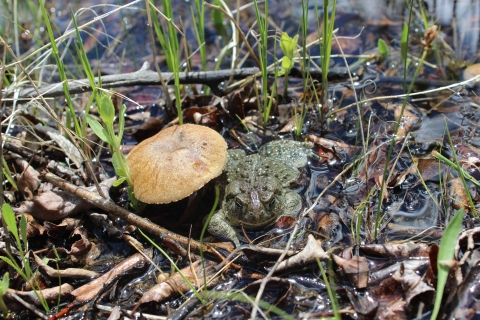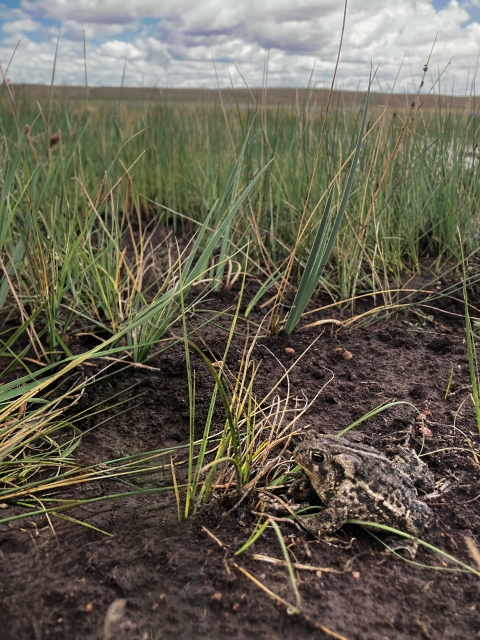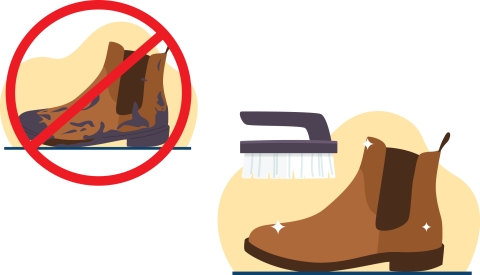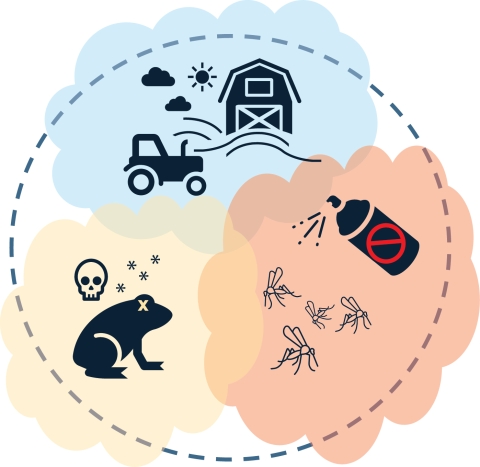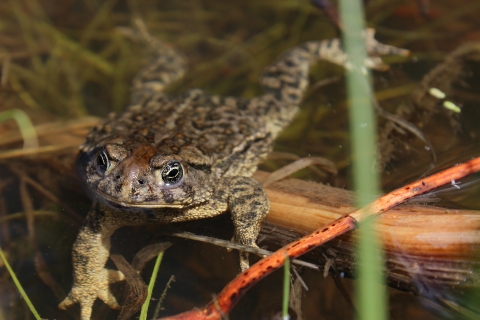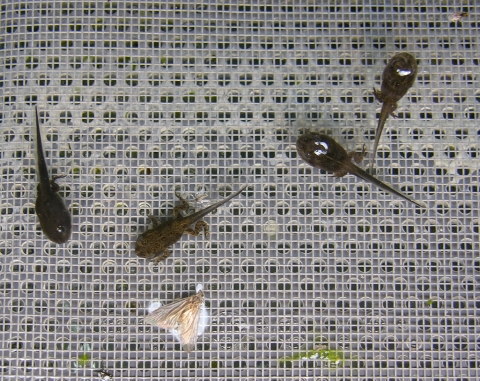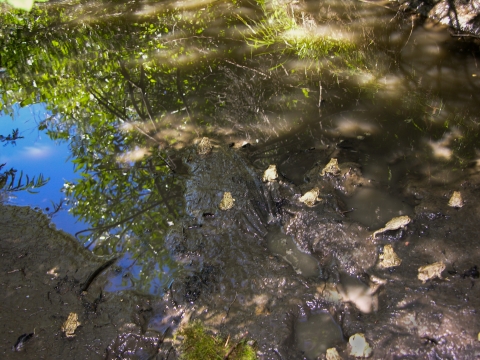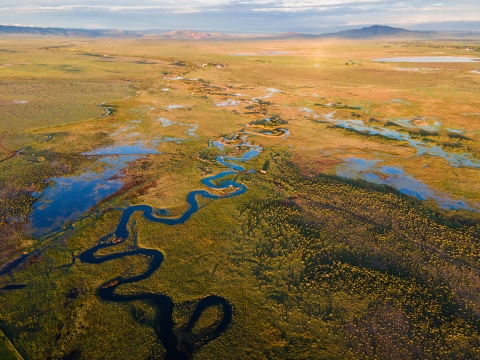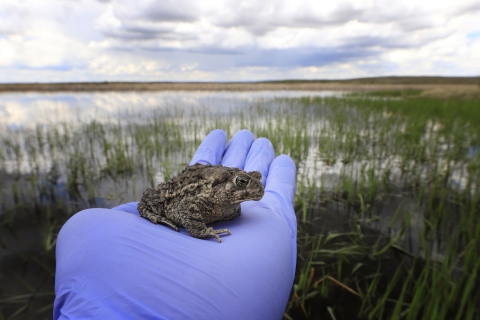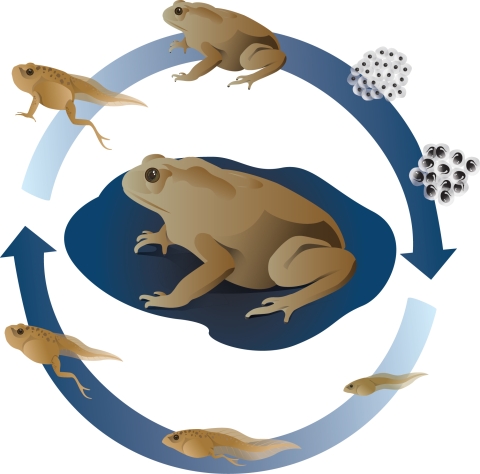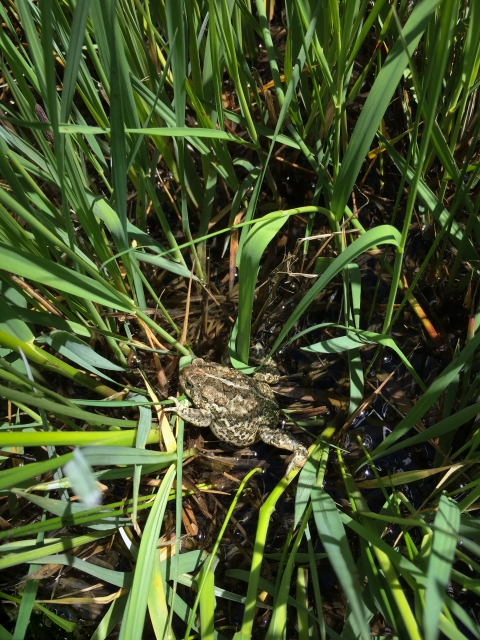About Us
The Wyoming Toad - Small, Elusive, Lumpy and Rare
If you are lucky enough to hear Wyoming toads in the wild, their calls consist of long rhythmic croaks separated by brief pauses, you might describe their croaking song as: waa-waa-wha-wha-ah-ah-ah-ah ... ... ... waa-waa-wha-wha-ah-ah-ah-ah
This toad looks lumpy, its body is covered with warts and its head has a humped ridge. The skin is various shades of brown, this is perfect for blending in and escaping would-be predators. At its full size, the Wyoming toad is only two inches long. Female toads grow slightly larger than males, but all Wyoming toads have fused cranial crests (bony ridges on the top of their heads) that differentiate them from other toad species.
Wyoming toads spend warm months above ground as voracious carnivores of invertebrates and other prey items. Different life stages of toads likely have different diets, but in general, ants, beetles, flies, worms, and other assorted invertebrates, are the bulk of their prey items. Tadpoles have mouthparts suited for scraping surfaces and have been observed feeding on algae. During colder months, they retreat below ground to hibernate and wait out the winter.
Habitat
Wyoming toads require pockets of warm, shallow water to breed. Ideally these ponds exist with a mosaic of grass and shrubland habitat containing sparse open areas for foraging and basking that are nearby denser vegetation for shade and protection from predation. Wyoming toads frequent the edges of lakes and ponds of the shortgrass prairie ecosystem and are rarely found more than 30 ft from water.
Habitat requirements vary according to different toad life stages and the density of vegetation needed tends to increase with age. Limited cover and ample sunlight are ideal for small toads while denser vegetation is used more by adult toads at night. Areas of low stem-density plants allow for free movement of breeding toads and allows light to reach shallow areas where warm water is required for embryo development. Tadpoles tend to prefer warm water and seek deeper water during the evening in response to the nighttime cooling of the shallows. Rodent burrows found in uplands are also an important component of Wyoming toad habitat, not only for refugia in hot weather, but also for hibernation. Wyoming toads begin selecting hibernation sites in late summer/early fall, spend the winter below ground, and emerge sometime in the spring to breed, depending on weather conditions.
Chytrid Fungus - What is it? What can you do to help?
What we commonly call Chytrid fungus is a relatively recently discovered fungus that is responsible for amphibian die offs across the world. The full name for it is Batrachochytrium dendrobatidis, and it is abbreviated as “Bd”. Bd is a member of a group of fungi called chytrids, which are usually found underwater growing on dead plant or animal matter. Bd is the only chytrid fungus known to feed on living vertebrates. It primarily affects the skin of amphibians, causing the disease known as amphibian chytridiomycosis. Bd is currently found on every continent where amphibians exist, but nobody is sure where it came from, or how long it has been where it is now.
Amphibians breathe and take up water through their skin. Chytridiomycosis interferes with these essential processes. Infected toads may become lethargic, they are often unable to right themselves if turned upside down, and they may jump or swim in circles. They may rest with their legs outstretched or sit with their rear end raised up. Sometimes their skin appears bloodshot or sloughs off excessively. They may also sit out in the hot sun when healthy amphibians would seek shelter in shade or water.
Chytrid fungus can be transported from place to place in water or mud, including on wet or muddy footwear. You can prevent spreading it by making sure to clean your shoes well and let them dry thoroughly between visits to different places. This is also true for anything else that will come into contact with water. To be extra safe, you can brush items clean and then disinfect them with a weak solution of bleach. Also, do not transport live animals from one place to another.
History of the Wyoming Toad and the Wyoming Toad Conservation Area | |
|---|---|
1970s Population DeclineScientists discovered a major decline in the Wyoming toad population. Changes in habitat along with the spraying of insecticides to control mosquitoes, changes in agricultural practices, increased predation, and disease (Chytrid Fungus) have been suggested as causes of decline for the Wyoming toad, as well as other amphibian species. | |
1980s Endangered SpeciesThe Wyoming toad is officially listed as an Endangered Species under the Endangered Species Act (ESA). | |
1987 Wild Toads are FoundThought to be the last existing in the wild, a population of Wyoming toads is found. The toads are found on private land that would eventually become Mortenson Lake National Wildlife Refuge. | |
1990s Captive Breeding ProgramWild populations of the Wyoming toad continue to dwindle, the decision is made to bring the last remaining toads into captivity for breeding. | |
1993 Mortenson Lake National Wildlife RefugeMortenson Lake National Wildlife Refuge is established in 1993 under the Endangered Species Act to support the last known population of the Wyoming toad. | |
2000s The Wyoming Toad Recovery Team is FoundedThe recovery team includes experts from the Association of Zoos, Wyoming Game and Fish, the University of Wyoming, private landowners, the US Fish and Wildlife Service and others. | |
2016 First Adult Toad ReleaseThe release occurred at Mortenson Lake National Wildlife Refuge and other appropriate toad habitats in the Laramie Basin. Tadpole releases have been occurring, with minimal success, since the 1980s. | |
2016 The Wyoming Toad Land Protection Plan is FinalizedAs a result of many years of outreach, stakeholder input and dedicated work the Wyoming toad Land Protection Plan (Plan) is finalized. The Plan describes the priorities for acquiring up to 43,200 acres mostly through voluntary conservation easements, including up to a maximum of 10,000 acres in fee title. Finalization of the Plan allowed the US Fish and Wildlife Service to begin to pursue processes to set aside land with appropriate habitat for the benefit of the Wyoming toad with a goal of advancing recovery efforts. | |
2020 A Banner YearBecause of a banner year of captive toad production 18,000 Wyoming toads are released into the wild. Toads of all life stages are released including adult toads, toadlets and tadpoles. | |
2023 The Wyoming Toad Conservation Area is EstablishedThrough a land acquisition, the Wyoming toad Conservation Area is established. The US Fish and Wildlife Service purchased the Bath Ranch, using the Federal Land and Water Conservation Fund. The Bath Ranch was purchased from The Conservation Fund, a national nonprofit focused on land and water protection. The Service had been working with The Conservation Fund, The City of Laramie, the Wyoming Game and Fish Department, and the Laramie Rivers Conservation District for several years to reach this key milestone. | |
Today the Wyoming Toad Population is ImprovingSeveral captive breeding programs are still in effect, and some reproduction in the wild has been observed. Breeding programs exist in several locations, including the US Fish and Wildlife Service Saratoga National Fish Hatchery. Water management, infrastructure repairs, grazing and prescribed fire are some of the tools that may be utilized to accomplish management goals. Adaptive management is the practice of using different tools for management, observing what works well and making adjustments going forward. Grazing of local cattle has a proven history as an important management tool to improve habitat for the Wyoming toad. Prescribed burning may also be used to help create open areas for the cold-blooded toads to be able to soak up the sun and the open areas help to encourage plant and invertebrate growth in the high elevation basin. | |
The Future is Bright for the Wyoming ToadThrough the continued passionate and dedicated research and work of the US Fish and Wildlife Service and many partners, we hope that the Wyoming toad will once again thrive throughout the Laramie Plains of Wyoming. “It takes a village to recover a toad.” - Douglas Keinath USFWS, former recovery coordinator The US Fish and Wildlife Service will continue working with partners to seek opportunities for developing conservation easements within the Wyoming toad Conservation Area. A conservation easement conservation easement | |

